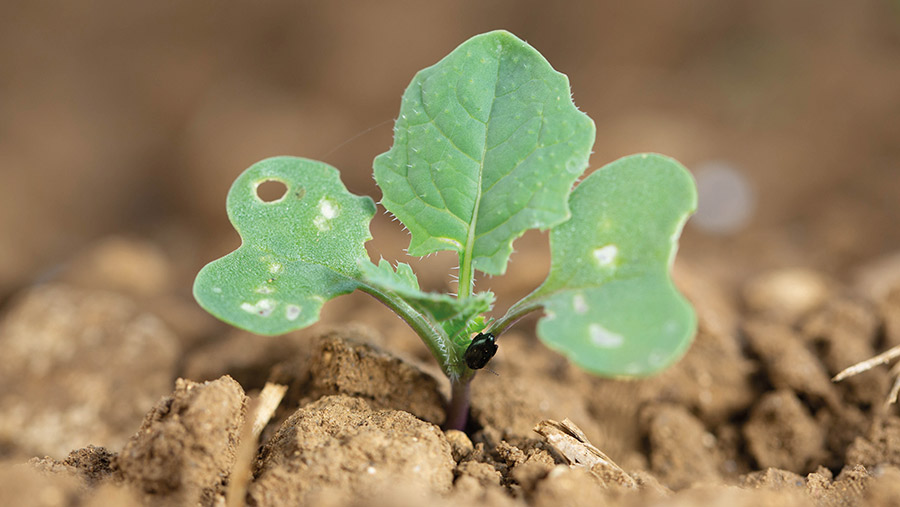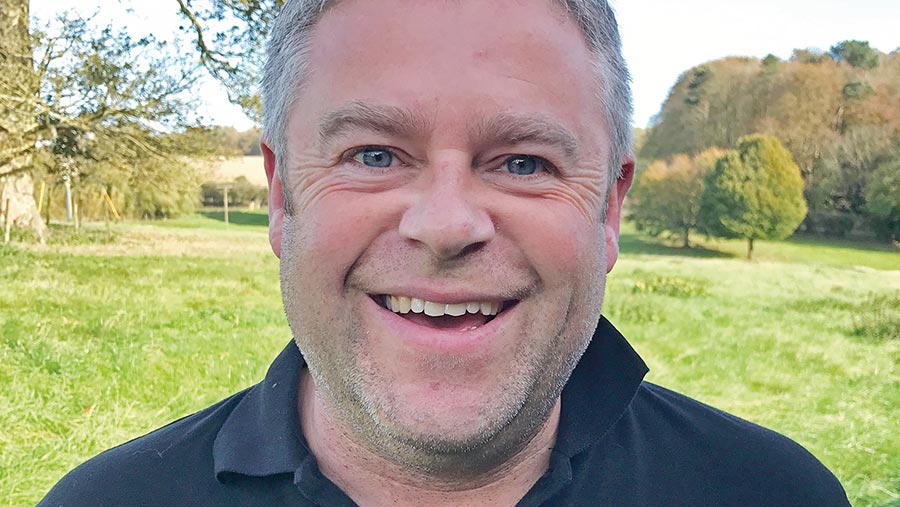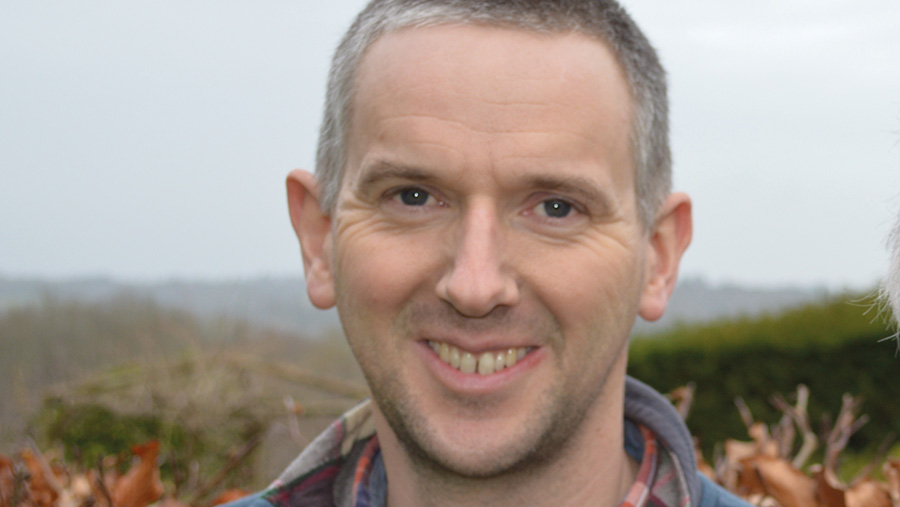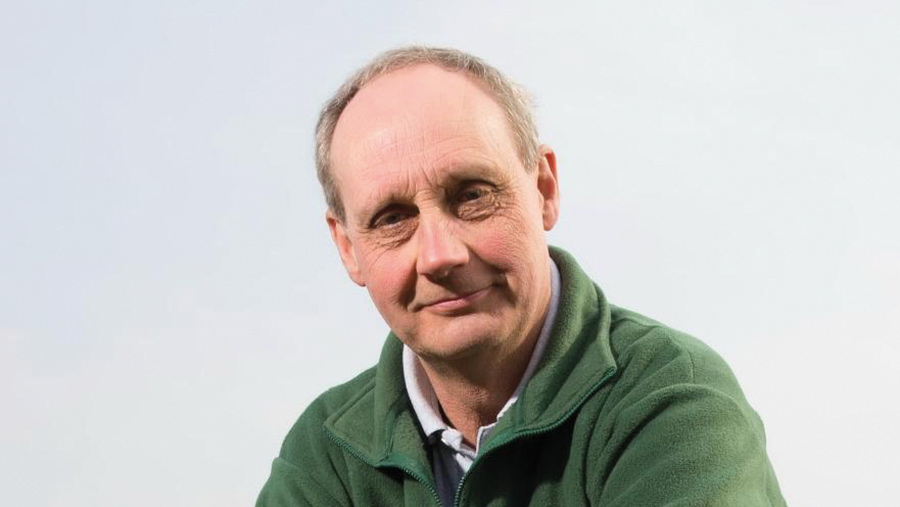Four OSR growers try different strategies to beat flea beetle
 © Tim Scrivener
© Tim Scrivener Despite its reputation for being a risky and expensive crop option, oilseed rape is currently enjoying better market prices and growing demand – but will that be enough to reverse its decline?
In this article, Farmers Weekly speaks to four growers who are making oilseed rape work, but in different ways.
All have widened their rotations and prioritised moisture at drilling, but that’s where the similarities end.
See also: Garlic-based nematicide shows promise for Yorks root grower
Paul Davey, Market Rasen, North Lincolnshire

© Paul Davey
Taking a crop break
Oilseed rape is being grown for the first time in five years by Paul Davey, after a planned break from the crop.
Having seen a drop in yield back in 2015, which he attributed to a tight rotation, Mr Davey decided to reintroduce the crop this year on a no more than one-in-six basis.
That has meant reducing the oilseed rape area from 140ha to about 60ha and opting for a different establishment system, as the business is now in its fifth year of direct-drilling and following a regenerative agriculture approach.
Natural pest control
As such, he has stopped using insecticides wherever possible and is relying on beneficials to provide natural pest control, with biological products also being tested to see if they can help.
With five farms on a range of different sol types and altitudes, Mr Davey has to use different strategies for growing oilseed rape, depending on location.
However, across all sites he sticks to using conventional varieties and home-saved seed, only drilling when there is moisture, so that the crop gets up and away.
Varieties
He describes conventional varieties as “not so racy”, making them less prone to pest attack. This year he has Aspire in the ground, chosen for its turnip yellows virus resistance and good agronomics, with shallow establishment achieved with a low disturbance toolbar in mid-August.
“Flea beetle has been a problem in the past but having rain at the critical establishment time seems to help depress their activity, which is what we saw,” he comments.
“Looking at the crop now, we have a very low number of larvae in the crop, as well as a small amount of stem weevil.”
He used a silicon-based biological product in the autumn to see whether its cell wall strengthening properties could help with pest control. “We applied it just before temperatures started to rise, as that’s when flea beetle activity increases.
“It was another pass, but we are keen to maintain beneficial numbers and not do anything to disrupt them.”
He resisted using a companion crop, as he was keen to focus on the oilseed rape getting the best possible start.
“We know that speed of establishment ahead of rainfall is important and we can get great output from our 8m drilling unit, going at 70 seeds/sq m.
“At such a busy time of year, there are only so many hours in the day. Having something else to manage didn’t seem sensible.”
Richard Budd, Hawkhurst, Kent

Richard Budd © David Jones
Drilling in late September
Late drilling is the cornerstone of Kent grower Richard Budd’s oilseed rape strategy, which has seen him achieve 100% establishment for the past five years, as well as some very high yields.
Delaying the drilling operation until after 10 September means that he gets no flea beetle in the newly emerged crop, as it avoids the warm spell that typically arrives in early September, bringing flea beetle activity with it.
Integrated pest control
In an integrated pest management strategy that avoids the use of insecticides, he also takes out volunteer oilseed rape in that early-September period, removing the incoming beetle’s food source.
“The crop emerges in early October, is at the six-to-seven leaf stage in November and we have full cover by Christmas,” he says.
“Success does depend on having warmer autumns and a mild early winter, but that has been the trend for the past few years.”
This year’s crop was drilled between 19-23 September, but he has gone as late as 30 September and still achieved 5t/ha.
“Moisture levels are critical for good establishment. We direct-drill and then double roll, to conserve seed-bed moisture.”
Varieties
Mr Budd uses home-saved seed of conventional varieties to keep costs down and plants 100 seeds/sq m.
He has grown Campus for the past five years and finds that the combination of its late-flowering habit and September drilling date is an asset in a year with late spring frosts, such as this one.
“It was still in green bud in mid-April, so didn’t get damaged,” he says. “It means that harvest can be a bit later but yields don’t suffer at all.”
Up to 200ha of oilseed rape is grown in a one-in-seven rotation, with growing costs having fallen since he moved away from drilling hybrids in August.
“No pre-emergence herbicides are used as we find that Centurion Max (clethodim) followed by Astrokerb (aminopyralid + propyzamide) works a treat for weed control.
“We then shut the gate until spring, when we use two plant growth regulator-type treatments at full rate, as we have thick crops at that stage.”
Good drainage is important too, as much of the farm is heavy clay soils. “Where drainage isn’t working well, for whatever reason, we’ve seen a 2t/ha yield drop. Mole draining has been the answer.”
Last year’s crop averaged 6.26t/ha and Mr Budd won the OSR YEN Gold Award in 2019 with a yield of 7.19t/ha – so he sees no reason to make changes.
“This year we are doing a three-way trial with Aardvark and Acacia, comparing them with Campus, to see if there’s any benefit to be gained from moving on.”
Chris Eglington, Dereham, Norfolk

Photo supplied by Chris Eglington
Getting a big plant
In mid-Norfolk, Chris Eglington’s strategy for success is to get a big oilseed rape plant that can withstand flea beetle attack.
His approach appears to have paid off, with yields approaching 5t/ha and oilseed rape being the most profitable crop on the farm, just outperforming wheat.
To this end, he precision drills the crop as early as possible – starting at the end of July, establishing 24 plants/sq m. This helps achieve a very even establishment, with liquid urea and slug pellets also being applied at drilling.
“It seems to help with flea beetle if the plants all emerge together,” he says. “This year’s crop had three drilling dates – 29 July, 6 August and 11 August – and all of them benefited from some rain.”
Sheep in rotation
He has used sheep to graze his oilseed rape crops in the autumn for the past three years, but describes the first two years as a waste of time.
Both attempts resulted in a 1t/ha yield loss, with the sheep being introduced in January in the first year and at the end of October in the second.
This year, the sheep went in for a week in mid-September, with Caryx (mepiquat + metconazole) being used subsequently. He now has really bushy plants from multiple branching, which he hopes are set up for a good harvest.
Varieties
Conventional variety Barbados has been grown for the past few years, with Mr Eglington home-saving seed and putting it over a gravity separator to select a larger seed size. He will do the same with some Aspire this year.
“Big seed is important,” he says. “I’m looking for a seed size of 4.5-7, as the larger seed gives me a bigger plant.”
Previous use of buckwheat as a companion crop has shown the buckwheat to be competitive, resulting in lower oilseed rape plant populations, so that will be abandoned, he adds.
The average plant count at harvest is 13 plants/sq m, which ranges from seven to 19 plants.
“I’m convinced low seed rates is the way to go but my subsoiler/precision drill system is slow, so I am doing a trial this year using a Vaderstad Rapide.
“Most of the crop was drilled at 24 plants/sq m, but there are three areas at 35 plants/sq m, which I will drop to 30 next year. The Rapide has allowed me to get it all drilled in a day.”
Colin Chappell, Brigg, Lincolnshire

Colin Chappell © Alan Bennett
Mowing the crop
Oilseed rape is a small but important part of the rotation at Chappell Farms, where a brave decision has been taken with this year’s crop.
Workload pressures at key times of the year have meant that Colin Chappell has had to dismiss later drilling dates and their associated pigeon risk, moving crop establishment to an earlier slot, in line with changes to his rotation.
Where oilseed rape crops are drilled into moisture, yields of 5t/ha have been achieved. But in difficult seasons he has recorded 3t/ha – reflecting the effect that the weather can have on his very heavy soils and ability for crops to perform consistently.
This year, with winter barley being grown for a nearby anaerobic digestion plant, the wholecrop’s June harvest allowed him to direct-drill oilseed rape into forage barley at the end of July at a seed rate of 4kg/ha, following an application of digestate.
Keen to avoid the main flea beetle migration period and not to use insecticides, he ended up with a crop that was knee-high and very thick by the start of November.
Unfortunately, it hadn’t escaped the attention of flea beetle, with larvae numbers in the plants being quite high.
In consultation with Dave Robinson of Crop Dynamics, Mr Chappell took the decision to flail mow the crop down, topping it off at the base of the plant.
He ended up with three distinct areas – mown, partly mown and untouched – giving them a comparison.
Mowing advantages and disadvantages
Flea beetle larvae counts undertaken by Mr Robinson have showed a 90% reduction in flea beetle numbers where mowing took place, with the crop recovering and starting to grow again in January.
“The downside is that it was so far behind that I had to spray for pollen beetle,” reports Mr Chappell. “I’m also a bit nervous about the effect that the late spring frosts may have had on the crop.”
In its favour are lower growing costs – the oilseed rape received herbicide in the form of Centurion Max (clethodim) followed by Astrokerb (aminopyralid + propyzamide), but no fungicides or other sprays were required.
“We’re not asking a huge amount from the crop, as in a bad year we get 3t/ha. The yield effect if mowing is done in the autumn shouldn’t be too bad – in the spring, it’s too much of a shock.”
Varieties
He has both Aspire and Imperial CL in the ground – parts of both of which have been mown.
“I would do it again. We are at the vagaries of the weather on this farm and it means the pest loading on that part of the farm has been reduced.”
He remains unconvinced about companion crops; having used berseem clover in the past, he ended up with just the clover.
“It can take the moisture that the oilseed rape plant needs. Getting the crop established is essential.”
Research on flea beetle control – csfbSMART Project
Helping oilseed rape growers to avoid disastrous crop years should be one of the quickest outcomes of a new three-year, cross-industry research project, csfbSMART, which starts in 2021.
As project co-ordinator Colin Peters of Niab explains, the project aims to share and develop the management and agronomy research tools that exist for flea beetle control, as well as understand which techniques work best when used in a practical setting.
“A whole range of factors have to come into play with growing oilseed rape, including adult flea beetle behaviour and the weather,” he says. “Without effective chemistry, there’s a need for IPM approaches.
“We know what small plot work tells us, now we want to get a landscape view and develop a bigger picture.”
As a result, the researchers will team up with growers and agronomists so that they can understand how the pest is behaving nationally, as well as investigate the regional differences that occur.
Monitoring will be rolled out, with some farmers doing their own on-farm monitoring using equipment such as water traps, while others will provide data or give researchers access to their crops.
“Getting this information back will help with decision-making,” says Mr Peters. “Where flea beetle is concerned, we need to understand when not to do things, just as much as when we should be doing them.”
There is still plenty of missing information where the pest is concerned, he highlights, illustrating this by pointing out that we often hear that adult beetles come out of hedges as the crop emerges.
“We don’t know if this is correct, nor do we know where they go next.”
Different measures will be tested – from leaving a longer stubble length, to growing trap crops, defoliating plants and using digestate, as well as gathering more data on varietal differences.
“We are seeing varietal effects, but we don’t know if they’re due to plant architecture or preferential egg laying, or something else,” he notes.
Our sponsor’s message

What is OSR Future?
Corteva Agriscience is delighted to sponsor OSR Future, a series following the progress of the 2020-21 oilseed rape crop and exploring how farmers are changing the way they grow the crop.
Oilseed rape is a vital part of the rotation and Corteva remains committed to helping deliver the tools to ensure the crop has a bright future with farmers.
Challenges will be overcome by new thinking, open minds and innovation, allowing new strategies to emerge.
This year we have seen seed breeding excellence from Pioneer with the launch of PT303, the first hybrid variety with a sclerotinia tolerance trait, which achieved National Listing and excellent rankings in the AHDB Candidate List trials.
With an innovative R&D pipeline, fantastic varieties alongside proven crop protection products – such as Astrokerb, Kerb Flo 500, Belkar and Korvetto – farmers will be equipped with the tools they need to maximise the potential of their crops.
Thanks to Corteva, whose sponsorship has made it possible for us to run the OSR Future series. Farmers Weekly had full editorial control of this report.

